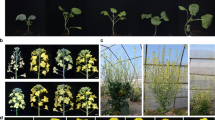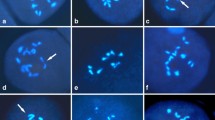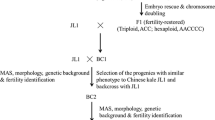Summary
Hybrids between B. inermis Leyss (2n=8x=56) and B. riparius Rehm. (2n=10x=70) were easily made. The F1 hybrids had a fertility of 20%–50% under open pollination and backcrossing to B. inermis. Chromosome pairing in B. riparius was predominantly as bivalents (29.04–33.85 per cell for plant means). Bivalents also predominated in the F1 hybrid (2n=9x=63) and there was a high level of pairing with no reduction in chiasma frequency. It was impossible to estimate the frequency of auto-versus allosyndetic pairing. Chromosome pairing in a hybrid between B. arvensis (2n=2x=14) and B. riparius confirmed that the B. riparius complement is capable of complete autosyndetic pairing. Chromosome numbers in the F2 progeny ranged from 2n=56 to 72 but they were skewed towards 2n=63 to 70. Backcrosses ranged from 2n=56 to 63, as expected, with the distribution skewed towards 2n=56. Selection towards the 2n=56 level would be difficult in the F2. Empirical observation suggested that cytoplasm had a major influence on morphology in the backcrosses. Additional studies are required to determine the best breeding scheme to introgress germ plasm between B. inermis and B. riparius.
Similar content being viewed by others
References
Armstrong KC (1973) Chromosome pairing in hexaploid hybrids from Bromus erectus (2n=28) x B. inermis (2n=56). Can J Genet Cytol 15:427–436
Armstrong KC (1977) Hybrids of the annual Bromus arvensis with perennial B. inermis and B. erectus. Can J Genet Cytol 21:65–71
Armstrong KC (1980) The cytology of tetraploid “Bromus inermis” and the colchicine-induced octoploid. Can J Bot 58:582–587
Armstrong KC (1984) Chromosome pairing affinities between Old and New World species of Bromus section Pnigma. Can J Bot 62:581–585
Elliott FC (1949) The cytology and fertility relations of Bromus inermis and some of its relatives. Agron J 41:298–303
Hanna MR (1961) Cytological studies in Bromus species, Section Bromopsis. Can J Bot 39:757–773
Nath J, Nielsen EL (1981) Identification and chromosome numbers of some Bromus species. Crop Sci 1:375
Nielsen EL (1963) Cytology of F1 hybrids from interspecific matings of Bromus Crop Sci 3:141–145
Nielsen EL, Hanna MR, Drolsom PN (1962 a) Fertility relations and analysis of F1 progenies of Bromus species. Crop Sci 2:456–458
Nielsen EL, Drolsom PM, Jalal SM (1962 b) Analysis of F2 progeny from Bromus species hybrids. Crop Sci 2:459–462
Nielsen EL, Drolsom PM, Jalal SM (1965) Evaluation of backcross and self-pollination progenies from interspecific hybridization of Bromus. Crop Sci 5:339–342
Smith P. (1980) 44. Bromus L. In: Tutin TG, Heywood VH, Burgess NA, Moore DM, Valentine DH, Walters SM, Webb DA (eds) Flora Europa 5:182–189. Cambridge University Press, Cambridge
Snow R (1963) Alcoholic hydrochloric acid-carmine as a stain for chromosomes in squash preparations. Stain Technol 38:9–13
Tzvelev NN (1976) Poaceae. USSR Tribe 4 Dum. USSR Academy of Science Press, Leningrad, pp 530–608
Author information
Authors and Affiliations
Additional information
Communicated by A. R. Hallauer
Rights and permissions
About this article
Cite this article
Armstrong, K.C. Cytology of F1 hybrids and chromosome number of F2 and BC1 progeny of the cross Bromus riparius x B. inermis . Theoret. Appl. Genetics 79, 137–142 (1990). https://doi.org/10.1007/BF00223800
Received:
Accepted:
Issue Date:
DOI: https://doi.org/10.1007/BF00223800




